February 1, 2015 – Time flies when you are having fun, my last Blog was from La Paz and here we have just arrived at the Baja Fiesta Restaurant in San Vicente on Day 27. It was a long drive from Bahia de Los Angles but thankfully uneventful. The Gang is definitely looking forward to a good meal from Cecilia and we are confident her and the boys will deliver. As a bonus the Super Bowl is playing today.

The remainder of our time in La Paz since the last Blog was lots of fun after a visit to Ibarra’s Pottery, a walk and look about on the Malecon and later a wonderful dinner at dinner at Los Magueyes, including our favourite musicians. David and Darlene joined our group for dinner (now their new group) and joined in some tunes with his harmonica, it was great. The next day we retuned to La Paz, this time the market where Daniel purchased some fine looking boots and Mike a guitar. Many did drop into the weird and strange Yenke Hotel, always an interesting visit
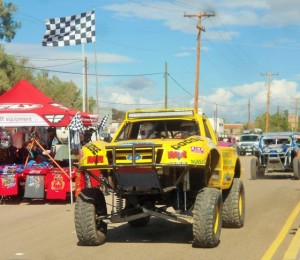
Later on our 3rd day Dom & Diane showed up with their tour and later we had a combined Happy Hour. Chris & Dixie and Les and Anne form our fall tour also joined in. Les & Anne are joining us on this return, Chris & Dixie are returning on the February tour. Rain dampened things but certainly not our spirits and we were able to head into shelter thanks to Cindy. The next morning we said goodbye to Daniel & Lise, Paul & Lise from Quebec, Daniel shared some very thoughtful words with his traveling companions, we will certainly miss them for the remainder of the tour. We welcomed David & Darlene (Manitoba) and Les & Anne (Alberta) to the Caravan, they dropped off in December. This tour has now evolved to have a very a western Canadian feel as every province is represented.
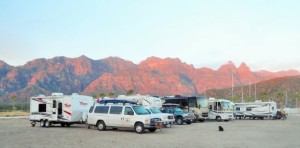
Our drive from La Paz to Puerto Escondido went smoothly aside from a rain burst, we started out cool, but reached 30C east of Ciudad Insurgentes and then cooled down as we descended to the Sea of Cortez. The construction zones just north of La Paz were in much better condition. Clearly the three (3) sections, 8KM, 1KM, 3KM, respectively, had seen a grader and with a little rain the dust was down as well. We are also encouraged to see workers and equipment on the site, this bodes well for our next tour. We arrived at Puerto Escondido on schedule, unfortunately the restaurant was damaged by Odile and may not open until February. Pedro has lost the lease but apparently Alma from Tripui will be operating the new establishment, we will see how this is. On arrival we had to re-negotiate our camping privileges, the new boss of the Marina did not want overnight campers cluttering his empty parking lot, fortunately his office is in Mexico City. Everyone seemed keen to explore this unique development, we had an impromptu Happy Hour lots of fish to look at and the next morning the sun did shine and the mountains were red, always impressive.
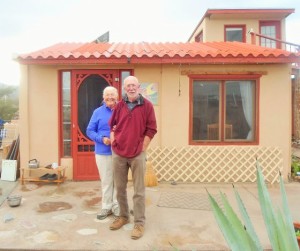
After the sunrise show we departed for Mulege and the Hotel Serenidad, a short driving day that is very scenic as we retrace our journey northward on Hwy 1. We were set up by 11:30 am and our friends from Kansas, Mike and Kelly (January 2013 tour) arrived shortly after we did. We headed into town with most members of the group to drop off the laundry and see the sites. The road to the Lighthouse has not been repaired but they have reconnected the Malecon at both ends. We toured the legendary Loma Linda, drove up to the Museum (former prison), the Mission and valley lookout and dropped by Chris & Jeannie’s who live in the Orchard. Lots of folks hard at work cleaning up and rebuilding after Odile. That evening Lisa & I and Mike & Kelly had dinner at Doney Mely’s in town, it was OK, my Carne Asada was tough but tasty.
The group really enjoyed their time at the Serenidad, as did the staff having something to do. The weather was warm so we had lots of poolside time, folks had breakfast, lunch and dinner at the Hotel and many spent some time at the bar over the course of our 2 night stay. Lisa and I, Kelly & Mike had dinner and played a game of Mexican Train, fun for sure. The tour and shopping in town went well, some purchases in different shops, lunch at a variety of locations, we really spread the wealth around. Overall it is fair to say the entire gang enjoyed their time at the Serenidad and Mulege, just a great place to relax in a stress free environment.
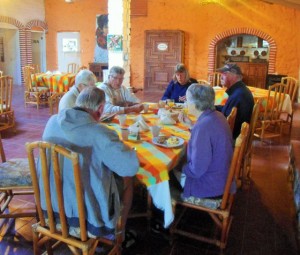
After two nights in Mulege we were off to Guerrero Negro this time staying at Mario’s. A long drive but again uneventful. Our drive up from Santa Rosalia on the Cuesta del Inferno was slow but scenic as we followed a Tractor Trailer working hard and going slow, certainly no passing by us however locals ripped by whenever they saw a break. We arrived at Mario’s and it looked like rain (which it did later), some collected shells, others updated their email, a few had dinner, we watched a movie, Snow Piercer, very odd and Sci-Fi. Dave & Darlene mad arrangements to see the Grey Whales at 8 am the next morning, this was our last evening on tour in Baja California Sur.

Our drive to Bahia de Los Angeles from Mario’s in Guerrero Negro was a bit different, often we encounter fog for the first 20 to 30 minutes, this time none, but overcast with a few sprinkles. We did get some blue sky, just patches here and there and it started to rain (light showers really) in the last stretch as we descended into the town. It was the last 20 km/16 miles of the drive did we start to see the damage caused by Hurricane Odile, the water coursing across the desert, carrying vast amount of sand and debris cutting into the road wherever they met. As we were on our last 5 km/3 miles before the viewpoint we could see the newly carved out canyon on our right, quite stunning actually. Then when we reached the overlook and saw the whole landscape below we were shocked, the arroyo had brought millions of tons of sand and water across hundreds of acres north of the town right to the sea. The town, almost a hundred years old now, has never experienced a weather event evenly remotely similar to this.

We stopped for fuel and could see the damage everywhere, some areas repaired, others not. We headed directly to Daggetts, got set up some and walked over to see our friends Antonio and Bety at Campo Archelon. Only Bety was home as Antonio was out taking a group into the mountains to see the big Rams. All of us walked over to Brisa Marina, the old government RV Park we stayed at since 1985, yes 30 ago. We were speechless at the damage Odile had caused, one of our favourite camping spots had taken a direct hit with all the water from the upper desert, carving small canyons thru many sections of park, oddly the old rundown buildings were not touched; too bad they remain an eyesore. The good gravel road in to the park has now been replaced by a sand filled wash. This park may never see another camper unless someone is prepared to invest some significant funds.

Took the gang to town for an impromptu visit and shop. David and Darlene showed up after staying back in Guerrero Negro to see the Grey Whales. Later Lisa and I dropped by George and Lea’s house at Daggett’s Camp and caught up on life in general, what a great couple. 9:30 am the next morning and off to the town for our planned excursion which included the Bahia de Los Angeles Baja 200 race start. We saw the start of the race for Trophy Trucks, Dune Buggies and Volkswagens, the Motorcycles had left much earlier. The headed to the local Museum, Diaz Onyx Chapel and lastly up to the overlook. With sunny skies LA Bay looks so much more beautiful from this vantage point. Later Lisa and I headed over to Antonio & Bety’s house in Campo Archelon for some red wine (Vino Tinto) and conversation with some folks from the camp, Canadians and Americans. The gang definitely enjoyed their time in Bahia soaking up the beauty and new much larger beaches. This morning we left northbound again on the longest driving day of the tour 385 km/237 miles.

Did you know?
The two most significant events in Mexico after the Spanish had conquered the indigenous people was firstly the Independence from Spain and secondly the Mexican Revolution. The primary financial promoters of independence in Mexico in 1810 were a few wealthy families with large parcels of land or “Latifundios”. By the end of the struggle for independence from Spain this class of Mexicans (less than 5% of the population) owned more than 90% of the land.

The Mexican Revolution (Civil War of 1910-1919) was a combination of Mexicans wanting to end the 30 year dictatorship of President Porfino Diaz (called the Porfiriato) and access to the ownership of land by all Mexicans. In 1920 the concept of the Ejido (eh-hee-doe) was adopted by Mexican President Alvaro Obregon, in the form of the “Ley de Ejidos” (Ejido Act). The government ceded land to local inhabitants, as a community, mostly of Indian origin, for use as farmland. Initiated during a period when vast areas of Mexico were sparsely populated, there was no concept of individual land ownership. The new farming community, or “Ejido” could decide whether they wanted to hold all of the land public for the use of every member of the community as a collective; or it could decide whether they wanted to permanently distribute it individually to its members. An “Ejido” has some governance similarity to the American or Canadian Indian Reservation and the structure of a communist commune. Today, Ejidos still manage much of the collective ownership of land in Mexico that includes electing administrators who function much as a mayor and his staff do in small towns in the U.S. In 1934, the Ejido act was made part of the constitution and has been continually amended. Prior to 1992 Ejido land was owned entirely by the Mexican government who recognized systemic problems, as Ejido members illegally leased or sold their farmland. In response, Mexican legislators in 1992 approved the “Nueva Ley Agraria”, the New Farm Act, and designating individual Ejidos as legal entities. An Ejido could then represent itself by elected board members that included legal property rights.

There are 3 types of Ejido property; land for human settlement, common land and farmland. Human settlement property is the most important part of the Ejido community and of most interest to foreign investors. It is the demographic concentration of homes, streets, parks, public services and also includes schools, land for recreation, industry and cultural activities. The individual Ejido general assembly, with the cooperation of municipal authorities define, locate, divide and record the land for human settlement. When formed, Ejido members have the right to become an “Ejidatario” (Ejido Landowner) by acquiring for free, a “Solar”, which is a lot within the Ejido land. The size of the solar is established by the Ejido General Assembly. Much of the Mexican economy is now flourishing thanks to the regulation changes made to the Farm Act which allows for the sale of Ejido Rights and/or transformation from Ejido Land to private property. “Ejidatarios” (Ejido landowners) can sell their land rights to other members or to other individuals already living in the Ejido community “avecindados”, but they must be Mexicans, foreigners or even companies are not permitted to acquire rights to Ejido property.

Buying Ejido Property. A foreigner can buy Ejido land, but the sale requires the agreement of the whole community that “own” it. The process for buying Ejido property as a non-Ejido member or foreigner can be time consuming and must be pursued with diligence, patience and expertise. The process can be accomplished in months or it can take several years. Until an Ejido has been transferred to private ownership, with title, there is no 100% safe way to buy Ejido property as a foreigner, although many do purchase this type of land. Foreigners need to weigh the risks of potential problems on one side, with the significantly lower land prices on the other before deciding to purchase such property. Normally these types of land purchases happen without incident however the potential for problems is there. Every land purchase transaction in Mexico requires an element of trust, like buying stocks, one should only invest what they would be willing to lose. Like investment in stocks, many people have made millions of dollars by purchasing Ejido property for little money, then selling it for many times what they paid after it has gone through “Procede”, the transfership from Ejido to public title ownership.

Since Ejido land is much less expensive than regularized land, many foreigners have elected to take the risk and buy Ejido property, however, they do so recognizing that they have absolutely no rights, until they are able to legally obtain a “Fideicomiso” (bank trust) of their own. A foreigner purchases Ejido property by placing the Ejido title to the land in the name of a trusted friend or relative who is Mexican, called a “Prestanombre”, who then becomes a member of the Ejido, relying on the hope that when, or if, the land is regularized, ownership can be converted to a “fideicomiso” in their own name. Trust in their “prestanombre” is a must as that person ultimately has control over the property in the meantime and the foreign “owner” has no recourse whatsoever in the Mexican legal system.

In the past, foreigners have purchased beachfront property from fishermen for peanuts, erected houses for little more, and then find that the fisherman’s long-lost cousin surfaces many years later to claim that the land is his because it initially belonged to a common grandfather. These cases have gone all the way to the Mexican Supreme Court, foreigners have been thrown off their land and treated as squatters. This happened in Ensenada several years ago on beachfront property that had come to be worth hundreds of thousands of U.S. dollars. Those Americans were not swindled, however. They knew they were not allowed to own that land; but they hoped that possession would be 9/10ths of the law. They took a risk and paid the price.
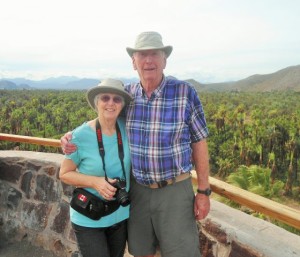
Unfortunately we have seen firsthand the consequences of Ejido leadership taking action that clearly was not well thought thru. In Mulege, the Loma Linda, built by Lou Federico in 1962, was a causality of an Ejido not understanding the value of first rate hotel on the local economy. The place has sat empty and deteriorating for more than 2 decades. And then we have the occupation of the Hotel Serenidad. On July 14, 1996 three decades of serenity at the Hotel Serenidad came to an abrupt end. It was a Sunday, and the hotel was packed with such regulars including a Superior Court Judge from San Diego, when 94 Mexican locals invaded and occupied the hotel. This was a dispute over land ownership and the Ejido (ejidatarios), evicted the owners and guests and seized the rooms, dining room, pool bar and airstrip. Locals in cowboy hats replaced well-heeled tourists beside a pool which was soon filled only with two inches of green pond scum. Ultimately Don Johnson & Nancy Ugalde de Johnson, a fifth-generation Mulege native, spent six months in court to prove that Nancy, Mexican born and bred, was the legal owner. Eventually a federal judge in Mexico City ruled that they had legal title to the land. As we all know the hotel did reopen, however things were never quite the same with underlying tension amongst some members of the community in Mulege years later. Throw in a few floods and it is fair to say the Hotel and community at large have never recovered.

RVers have not also not escaped the consequences of Ejido decisions. Playa Santispac south of Mulege is a good example. This has always been a popular stop for campers since the highway opened in 1973 (and before as the old road used be on the beach). Many Canadians and Americans leased property on the beach and erected various types of Casistas to cover and house their trailers and motorhomes. The Ejido then sold the beach (or did they?), the residents were evicted, the leases terminated, the Casistas eliminated and many RVers were left finding somewhere to camp. For many this was not a positive experience. Similar experiences have occurred in San Jose del Cabo (Brisa del Mar RV Park) and Cabo San Lucas (El Arco RV Park) which still stand abandoned and deteriorating undeveloped years after closing.


